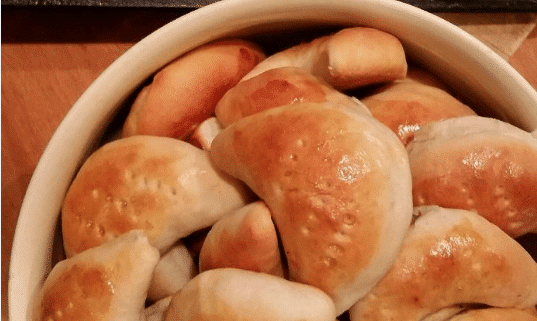As told to and adapted by her daughter, Eva Lubans Baughman
Ingredients
For the piragi filling:
- •454 grams (1 pound) lean ham, finely chopped*
- •227 grams (½ pound) lean bacon, finely chopped
- •1 large onion, finely chopped
- •5 ml (1 teaspoon) freshly ground black pepper
- •10 ml (2 teaspoons) sugar
For the piragi dough:
- •473 ml (2 cups) milk
- •25 ml (2 packages/about 5 teaspoons) instant dry yeast
- •113 grams (4 ounces) butter, melted and cooled
- •10 ml (2 teaspoons) salt
- •60 ml (¼ cup) sugar
- •480-600 grams (4-5 cups) all-purpose flour
- •Vegetable oil for baking sheets
For piragi assembly:
- •All-purpose flour, as needed
- •1 egg, beaten well in a small cup or bowl
*Author’s note: My mother always used boiled ham, such as Krakus brand, not smoky baked ham.


Preparation
For the filling: Combine all of the filling ingredients in a large skillet, and sauté on low heat to soften onion and render fat, about 5 minutes; do not brown. Set aside to cool.
For the dough: Because I use instant yeast, I do not “proof” the yeast, but instead combine all the ingredients, starting with 480 grams (4 cups) of flour. I gradually add flour a 60 ml (¼ cup) at a time until it is pulling away from the sides of the bowl and can be turned out onto a table or low counter to knead. Add more flour gradually and knead until the dough is soft and smooth (like a baby’s bottom!). This is where you have to go on your own a bit – as one develops a feel for this. The dough is ready when it is no longer sticky and has some resistance, but is soft. This usually takes 10 minutes of kneading.
Place in a large mixing bowl and let rise in a warm spot until doubled. Test it by pushing against the side of the dough with your finger, the impression should remains and not fill back in.
Preheat oven to 204°C (400°F) and oil three 25 x 38 cm (10 x 15 inch) rimmed cookie sheets. Punch down the dough and divide into three equal pieces, two of which you will use for making pirags; reserve the remaining dough for the kuchen sheet cake.
For assembly: Roll out a third of the dough on a floured board to approximately .7 cm (⅓ inch) thick. Using a cookie cutter or glass about 7.6 cm (3 inches) in diameter, stamp out circles. Press together and re-roll dough scraps. Pat each circle evenly with your fingertips to make it slightly larger in diameter, then place a heaping teaspoon of filling off-center toward the bottom half of the circle. Fold over the top half of the circle, taking care to not touch the filling with the edge, and press firmly along edge to seal. Tuck under so the seam is on the bottom and curve the ends down slightly to form a crescent shape.
Place the piragi on the greased pans in rows. Prick each one with a fork three times and let rise for 10 minutes. Brush with egg wash, wait 5 minutes, then place in preheated oven. Check for done-ness after 10 minutes; they should be golden brown and glorious. My mother said that any that opened up while baking were laughing.

